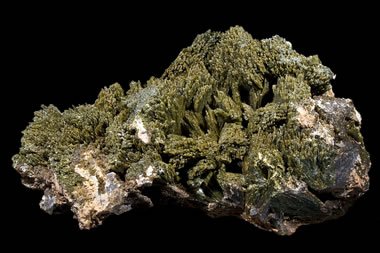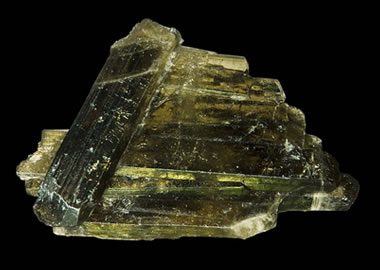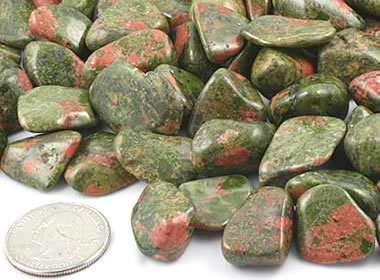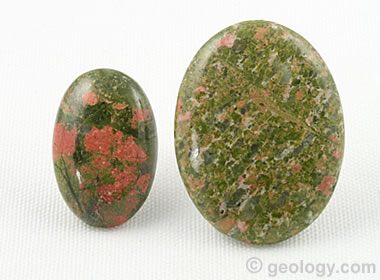Epidote
Epidote is a metamorphic mineral and the name of a silicate mineral group.
Article by: Hobart M. King, PhD, RPG

Epidote: Epidote from Rockbridge County, Virginia. This specimen is approximately 4 inches (10 centimeters) across.
What is Epidote?
Epidote is a name that is used in two different ways in mineralogy: 1) the "Epidote Group" is the name of a group of silicate minerals that share common structural and compositional characteristics; and, 2) "Epidote" is the name of the most common mineral in the Epidote Group.
Physical Properties of Epidote |
|
| Chemical Classification | Silicate |
| Color | Usually yellowish green to pistachio green, sometimes brownish green to black |
| Streak | Colorless |
| Luster | Vitreous to resinous |
| Diaphaneity | Transparent to translucent to nearly opaque |
| Cleavage | Perfect in one direction, imperfect |
| Mohs Hardness | 6 to 7 |
| Specific Gravity | 3.3 to 3.5 |
| Diagnostic Properties | Color, cleavage, specific gravity |
| Chemical Composition | Ca2(Al2,Fe)(SiO4)(Si2O7)O(OH) |
| Crystal System | Monoclinic |
| Uses | Semiprecious gem |
What is Epidote (the mineral)?
Epidote is a silicate mineral that is commonly found in regionally metamorphosed rocks of low-to-moderate grade. In these rocks, epidote is often associated with amphiboles, feldspars, quartz, and chlorite. It occurs as replacements of mineral grains that have been altered by metamorphism. It is frequently found in veins that cut granite. It occurs as monoclinic crystals in pegmatites. It is also found in massive form and as monoclinic crystals in marbles and schists that were formed or altered through contact metamorphism.
Epidote usually ranges between yellowish green to pistachio green in color. Less often it is brownish green to black. In massive form it is usually translucent with a vitreous luster. Well-formed crystals from marble and pegmatite are often transparent.
Epidote has a chemical composition of Ca2(Al2,Fe)(SiO4)(Si2O7)O(OH). It is an end member of a solid solution series with clinozoisite. In that series, the iron of epidote is gradually replaced by aluminum to the end member clinozoisite composition of Ca2Al3(SiO4)(Si2O7)O(OH). Clinozoisite is usually lighter in color than epidote because iron is what produces epidote's greenish to brownish color.
| Mineral | Chemical Composition |
| Allanite | (CaX)(Al2Fe)(Si2O7)(SiO4)O(OH) X is one of these rare earths: Ce, La, Nd, Y. |
| Askagenite | (MnNd)(Al2Fe)(Si2O7)(SiO4)O2 |
| Clinozoisite | Ca2Al3(SiO4)(Si2O7)O(OH) Sr sometimes substitutes for one Ca. |
| Dissakisite | (CaX)(Al2Mg)(Si2O7)(SiO4)O(OH) X can be Ce or La. |
| Dollaseite | (CaCe)(Mg2Al)(Si2O7)(SiO4)(OH)F |
| Epidote | Ca2(Al2Fe)(SiO4)(Si2O7)O(OH) Pb or Sr can substitute for one of the calcium. |
| Ferriallanite | (CaX)(Fe2Al)(SiO4)(Si2O7)O(OH) X can be Ce or La. |
| Hancockite | (CaPb)(Al2(Fe,Mn)(SiO4)(Si2O7)O(OH) |
| Khristovite | (CaCe)(MgAlMn)(SiO4)(Si2O7)(OH)F |
| Manganipiemontite | (XY)(Mn2Al)(SiO4)(Si2O7)O(OH) (XY) can be (MnLa) or (CaSr). |
| Mukhinite | (Ca2)(Al2V)(SiO4)(Si2O7)O(OH) |
| Piemontite | (X)(Al2Mn)(SiO4)(Si2O7)O(OH) (X) can be (Ca2), (CaPb) or (CaSr). |
| Uedaite | (MnCe)(Al2Fe)(SiO4)(Si2O7)O(OH) |
| Zoisite | Ca2Al3(SiO4)(Si2O7)O(OH) |
What is Epidote (the mineral group)?
Members of the epidote mineral group have a crystal structure that consists of isolated and paired silica tetrahedrons. They share a generalized chemical composition of A2M3(Si2O7)(SiO4)O(OH). "A" is a pairing of calcium, manganese, strontium, lead, or sometimes a rare earth element. "M" is usually aluminum pairing with iron, magnesium, manganese, or vanadium. Some of the member minerals of the epidote group are listed in the table with their chemical compositions.

Epidote and Piemontite: Tumbled stones comprised of epidote and piemontite, known as "Dragon Blood" or "Dragon Stone".

Epidote Crystals: Epidote from Rockbridge County, Virginia. This specimen is approximately 4 inches (10 centimeters) across.

Epidote in Unakite: Tumbled stones made from unakite, an igneous rock composed mainly of green epidote, pink orthoclase feldspar, and quartz. This unakite was mined in South Africa.
Epidote in Rocks
Epidote is a rock-forming mineral. Many regionally metamorphosed rocks contain small amounts of epidote. Two rock types that contain significant amounts of epidote are epidosite and unakite. Locations where these rocks can be found are rare, but at those locations significant amounts of these rocks can be present.
Epidosite is a metamorphic rock composed mainly of epidote with small amounts of quartz. It forms when basalts in sheeted dikes and ophiolites are transformed by hydrothermal activity or metasomatism.
Unakite is a rock that forms from the metamorphism of granite. Less-resistant minerals in the granite are altered to epidote or replaced by epidote, with the orthoclase and quartz remaining. It is an interesting pink and green colored rock that was first discovered in the Unakas Mountains of North Carolina, from which its name was derived.

Unakite cabochons: Two cabochons cut from unakite. The cab on the left is about 30 x 19 millimeters in size and is cut from material with a very coarse grain size. The cab on the right is about 39 x 30 millimeters in size and is cut from material with a fine grain size.

The best way to learn about minerals is to study with a collection of small specimens that you can handle, examine, and observe their properties. Inexpensive mineral collections are available in the Geology.com Store. Image copyright iStockphoto / Anna Usova.
Uses of Epidote
Epidote has no significant use as an industrial mineral and has only minor use as a gemstone. High-quality transparent crystals are sometimes cut into faceted stones. These have never attracted much interest in the commercial jewelry market, probably because their colors are not customer favorites. Most of the faceted stones produced are purchased by gem and mineral collectors.
Unakite is a popular rock used by lapidaries to make beads, ornamental objects, and cut into cabochons. It is considered to be a semiprecious stone. The bright pink and pistachio green colors are very unusual and attract attention. Unakite is popular as a tumbled stone. A small amount of epidosite is also cut into cabochons.
| More Minerals |
 |
Herkimer Diamonds |
 |
The Acid Test |
 |
Tumbled Stones |
 |
Zircon |
 |
Fool*s Gold |
 |
Kyanite |
 |
Rock Tumblers |
 |
Rhodochrosite |

Find Other Topics on Geology.com:

|

| ||

|

| ||

|

| ||

|

|
